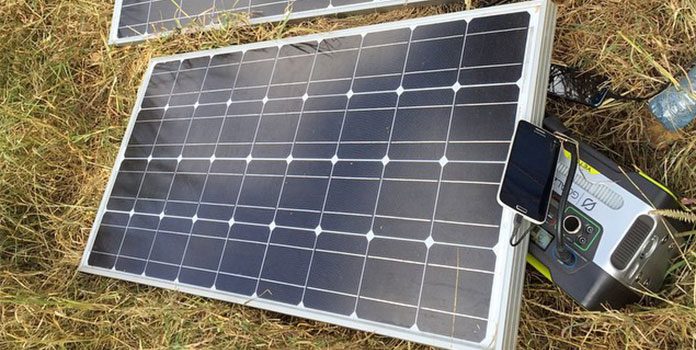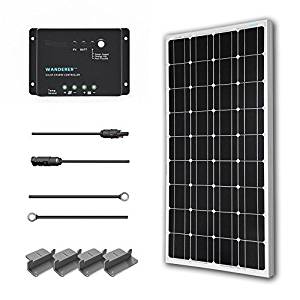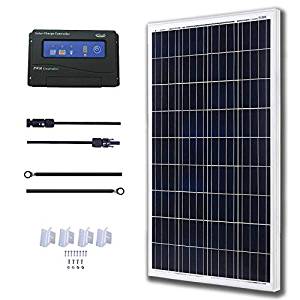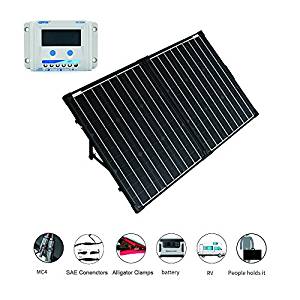Best 100 Watt Solar Panel Kit

Compare the Best 100 Watt Solar Panel Kits for 2018
If you’ve got an RV, camper van, or off-grid shed that needs some illumination then the best 100 watt solar panel kit solutions can easily and quickly get you running off the sun. They produce clean, no-cost energy and, thanks to their small size (only 1 solar panel!), are extremely easy to install as well. To help you on your quest, we scoured the market and chose our top 4 picks for the best 100 watt solar panel kits for 2018. Below, we go over why they’re the best, what customers have to say about them, and any pitfalls you might need to worry about. If you’re wondering exactly how much electricity a 100 watt solar panel can produce, keep reading afterwards for some help on deciding whether a 100 watt panel is right for you!
Best 100 Watt Solar Panel Kits for 2018
Small solar panel kits, those between 100 and 400 watts, typically include 1) the solar panel 2) the charge controller 3) the wiring to connect the solar panel to the charge controller and 4) mounting hardware to bolt the solar panel down. That’s it. Occasionally, they might include the inverter or the wiring to connect the charge controller to your battery, but these are really exceptions to the norm. These four pieces of equipment are necessary components to get you up and running off the sun, but they aren’t everything. You’ll also need a battery and inverter, as well as wiring and fuses to connect them all together. If you don’t already have these components, you’ll have to purchase them separately. Let’s start with our top pick for the overall best 100 watt solar panel kit, the Renogy Starter Kit.
Best 100 Watt Solar Panel Kit OverallRenogy 100 Watt Solar Starter Kit
Renogy 100 Watt Solar Starter Kit


Renogy is the king of equipment for small solar installations. They manufacture everything from panels, charge controllers, and mounting hardware to inverters, batteries, and battery-based generators (basically, portable inverter-battery combos).
Their Solar Starter Kit sets the standard for 100 watt kits, with quality components and hundreds of excellent reviews. The components are basic, but don’t skimp on quality. The kit includes:
- 100 watt monocrystalline solar panel
- 30 amp charge controller
- Mounting brackets (4) and necessary hardware
- Wiring from solar panels to controller
- Wiring from controller to battery
The solar panel is a standard monocrystalline panel, a cut above the cheaper and more common polycrystalline panel when comparing efficiency. The charge controller is also a pretty standard piece of equipment. It doesn’t include an LCD screen to provide any production or battery info like some of the more luxurious versions offer, but at 30 amps you’re able to add additional solar panels to the kit – up to 400 watts – without having to upgrade it. The mounting hardware and wiring is nothing special, though the inclusion of wiring to connect the controller to the battery is a nice touch, and one that most kits don’t include.
Despite the basic equipment, this kit is on the higher end when it comes to cost. What’s so great about it then?
This kit is probably the most popular 100 watt solar kit on the market today, with hundreds of great reviews to match. In fact, on Amazon, over 75% of reviewers give the product a perfect 5-stars – not bad! Customers praise the kit’s durability, ease of installation, and just how well the solar panel and charge controller work.
There’s cheaper options out there, but you get what you pay for. With your solar panel permanently drilled into your roof and your charge controller likely mounted in your battery compartment, you don’t want to worry about your equipment going bonkers in a year just because you didn’t want to spend an extra $40.
If you’re looking for a basic, high-quality solar kit that’ll last you for years to come, go for the Renogy! Click Here to Learn More About the Renogy 100 Watt Solar Starter Kit
Cheapest 100 Watt Solar Panel Kit
KOMAES 100 Watt Polycrystalline Tech Kit







Alright so you’ve already spent way more than you ever thought possible fixing up your RV and now you just want to put on the cheapest solar kit you can find. Hey, we totally get it.
If you’ve found yourself in this situation, check out KOMAES’ 100 watt Tech Kit. For a decent chunk less than the Renogy kit above, you get almost the same equipment:
- 100 watt polycrystalline solar panel
- 20 amp charge controller
- Mounting brackets (4) and necessary hardware
- Wiring from solar panels to controller
- Wiring from controller to battery
If you look closely, you’ll see that KOMAES is able to put together such a low-priced kit by using cheaper components than the Renogy kit.
First, you’ll notice that the solar panel is polycrystalline, a cheaper, but less efficient type of solar cell than monocrystalline. Poly cells allow the cost to stay low, but also requires a larger solar panel to produce 100 watts of electricity – though it’s not that much larger.
You’ll also see that the charge controller is rated for 20 amps, not 30 like the Renogy kit. At that size, you’re not able to add an additional 3 panels like the Renogy kit, but could probably get away with an additional 1 or 2.
However, like the Renogy kit above, this kit comes with wiring to connect both the solar panel to the controller and controller to the battery, again a nice feature that not all kits include!
Generally speaking, as price decreases, so does quality. And while this kit doesn’t enjoy the sheer number of reviews or the review quality of the Renogy kit, at its low price point the reviews are still surprisingly positive. Buyers generally report good experiences, with all the equipment working properly and the manufacturer providing decent customer service. However, a minority of customers did complain that the charge controller appears cheap or doesn’t work correctly, the wires are labeled incorrectly (positive vs negative), packaging and shipping is rough (with one customer finding their solar panel’s glass already broken!) and customer service is poor.
If you’re set on finding the cheapest 100 watt solar kit, KOMAES is certainly on the lower end of the spectrum, but still enjoys pretty decent reviews. However, many buyers have reported varying issues – so consider yourself warned. As far as cheap solar kits go though, this one’s pretty good. Click Here to Learn More About the KOMAES 100 Watt Polycrystalline Tech Kit
Best Folding 100 Watt Solar Panel Kit
ACOPOWER Solar Suitcase Kit







Both kits above include rigid solar panels designed to be permanently installed on your roof. This usually works great, as you can simply install them and forget them. As you’re driving down the road, your solar panels are working away, topping off your battery. However, what if you don’t want to install a solar panel on your roof? Instead, you want to store it in your RV while traveling. That way, you can park in the shade, but set your panel in the sun. Pretty smart, huh?
If that’s what you want, check out ACOPOWER’s sweet little solar suitcase kit. This 100 watt folding solar panel comes with a 10 amp charge controller pre-attached to the back of the panel. Simply connect the charge controller to your battery (with the attached wiring, including alligator clips to connect to the battery terminals) and you’re good to go.
The kit specifically includes:
- 100 watt folding monocrystalline solar panel
- Pre-installed arms to stand the solar panel up at an angle
- Pre-attached 10 amp charge controller
- Pre-installed wiring from solar panel to charge controller
- Wiring to connect charge controller to battery, with in-line fuse
- Carrying case
The monocrystalline solar panel is actually 2 50 watt panels, attached on one-side with a hinge so you can fold it up for transporting (it comes with a case for safety). The 10 amp controller is much smaller than the above 2 kits, but this is meant to be a stand-alone system – it’s not really designed for additional capacity. That being said, the manufacturer notes the charge controller can handle an additional 40 watts of solar if you so choose.
Like the Renogy kit above, ACOPOWER’s folding solar kit enjoys great reviews from buyers. Users note the solar panel and case are extremely durable and can withstand the wear-and-tear of life on the road. Many also note a very intuitive design that’s easy to use.
This kit, like all folding solar panels, is more expensive than either of the kits above. You’re paying more for a unique product that offers a few conveniences that the other kits don’t provide, namely the ease of use (you don’t even have to install anything).
If you’re looking for an all-inclusive, foldable solar panel kit, ACOPOWER’s is a good value with high-quality components. Click Here to Learn More About the ACOPOWER Solar Suitcase Kit
Best Square Solar Panel Kit
Renogy Polycrystalline Solar Starter Kit







RV roof space can be a bit cramped. Vents, skylights, AC units, and roof racks all vie for precious roof space. Adding a solar panel just complicates the matter, becoming a real-life Tetris game. Most 100 watt solar panels are long and rectangular, but what if you simply don’t have the space for that on your roof? Thankfully, not all solar panels are the exact same size.
Renogy makes a nice solar kit using their square-shaped 100 watt panel that might fit much better if you’ve got a cramped roof. This kit includes:
- 100 watt square polycrystalline solar panel
- 30 amp charge controller
- Mounting brackets (4) and necessary hardware
- Wiring from solar panels to controller
- Wiring from controller to battery
You’ll notice the solar panel is polycrystalline, but other than that it’s very similar to the Renogy kit above, and at a similar price point. And like the Renogy kit, this version also enjoys hundreds of great reviews, with most calling out the well-built components for high praise. So if you’re looking for a solar kit specifically with a square-shaped panel (well, at least more square shaped), this Renogy kit’s got you taken care of. Click Here to Learn More About the Renogy Polycrystalline Solar Starter Kit on Amazon
DIY 100 Watt Solar Panel
If none of the above kits suit you or you just like doing things yourself, you can easily put together your own solar ‘kit’. You might be able to save a couple bucks going this route, but that shouldn’t be the goal of this project. The offerings above are actually pretty good values when compared to piecing together your own kit.
Sill though, there are benefits to making your own kit. You can mix and match equipment to your heart’s content, since you’re not limited to the relatively short list of equipment that’s included in pre-made kits. You’ve seen that most solar kits are actually fairly simple and include just a handful of equipment. You can easily find all this equipment individually online, at about the same price as if you purchase them together.
And finding the right equipment is actually pretty easy. Just use one of the kits above as a base and go from there. To show you how easy it is, we’ve put together a simple, cheap kit that could work for anyone looking for a 100 watt system:
- A basic 100 watt solar panel from HQST
- Cheap mounting brackets from Windy Nation
- 20 feet of wiring with MC4 connectors pre-attached, to connect the solar panel to the charge controller
- and a cheap 20 amp charge controller
If you want to upgrade any piece of the equipment, it’s as simple as finding the right one! Let’s say you want a suitcase style solar panel. Well, check out this incredibly light folding solar panel from TCXW that comes in at just 5 pounds – that doesn’t come in any kit! Need a waterproof charge controller? Check out the Renogy Voyager. Maybe you don’t want to bolt your solar panel to your roof, but glue it down instead. Check out these slick corner brackets from Eco-Worthy designed to hold your solar panel down with adhesive. When you build your own kit, the sky’s the limit!
How much electricity does a 100 watt solar panel produce?


Smaller panels like in the kits above are used for situations that don’t need a lot of electricity. RVs and campers are the obvious choice, but 100 watt systems are also great for backyard sheds or small off-grid cabins as well.
So how much electricity does a 100 watt panel produce, and what exactly can it power? Let’s take a look.
In a perfect world, a 100-watt panel produces 100 watts of electricity in a single instant. If you leave the solar panel in full sun for 1 hour, it will produce 100 watt-hours of electricity (100 watts X 1 hour = 100 watt-hours).
In the real world unfortunately, a 100-watt panel produces less than 100 watts thanks to differing irradiation levels around the world, as well as clouds, rain, dirt, dust, and everything else that can block sunlight. Also, the other components of your installation aren’t 100% efficient. You’ll lose electricity as it flows through wires, fuses, and your charge controller.
Exactly how much electricity your installation will produce depends on your location, but a quick look at production data for southern California, Colorado, Virginia, and New York from NREL’s PVWatts calculator shows that you can expect your 100-watt solar panel to produce about 450 to 500 watt-hours of electricity daily during the summer months. In the winter, with snow and cloudy skies, your production will be much lower (about a 1/3 of summer production in New York!), but let’s focus on the summertime here, as most 100 watt kits are likely installed on summer-fun-seeking RVs.
Of course, if you need more electricity, you can simply connect 2 or more panels together. Adding another panel doubles your electricity output! Just remember that your charge controller, as well as your wires and fuses, need to be able to handle the extra energy safely.
So a 100 watt panel produces about 500 watt-hours/day. What does this exactly mean? Let’s look at a few real world examples.
What can I power with a 100-watt panel?
So how much is 500 watt-hours/day? Let’s take a look at what you can do with 500 watt-hours in a day:
- An Energy Star 24″ TV needs about 40 watts of electricity. Let’s say you watch a 2 hour movie while you’re camping out in the wild. That’s 80 watt-hours of electricity.
- The average hair dryer uses an astounding 1,875 watts – quite a bit more than the TV above! Say you use your hair dryer – on the highest setting – for 5 minutes every morning. Each day, that’s 160 watt-hours of electricity (1875 watts X .083 hours = 160 watt-hours/day). So even though your hair dryer uses an insane amount of electricity (it’s a very inefficient tool), you’d have enough power from a 100-watt panel to cover it simply because you use it so infrequently.
- Let’s say you also have 5 LED lights throughout your RV or shed, each of which uses 9 watts of electricity. If you use all of them for 5 hours every day, you’d use 225 watt-hours in total.
With these 3 gadgets, we’ve used a total of 465 watt-hours of electricity, just below our daily solar production. Of course, if you didn’t use a hair dryer – a notoriously inefficient item – and were a bit more conservative with your lighting, you’d have much more electricity at your disposal! Still, you can see that 100 watts really isn’t that much electricity. In fact, a 100 watt solar panel produces very little electricity!
The hair dryer, though, raises an interesting point. Compare the hair dryer’s wattage to the solar panel’s wattage. The hair dryer needs 1,875 watts to run. The solar panel can only produce 100 watts. What does this mean?
We’ve come across the issue of the solar panel’s capacity. Yes, over the course of a day, the solar panel can produce enough electricity for you to use your hair dryer, but you’d need a battery large enough to store all that electricity and put out at least 1,875 watts of electricity in a single instant.
If you simply connected the hair dryer to the solar panel, the solar panel couldn’t produce enough ongoing electricity to power the hair dryer. The solar panel’s capacity isn’t high enough. Even in a perfect situation, the solar panel can only produce 100 watts of electricity.
You can avoid this issue by connecting your small solar panel to a battery, allowing you to power gadgets that the solar panel alone simply couldn’t handle. The size of your battery depends on your electricity needs. The more electricity you use, the bigger the battery you need. In turn, the size of your solar panel depends on the size of your battery, and how quickly you want to recharge it once depleted. If you’ve got a battery bank with 500 watt-hours of usable electricity, it’ll take you about a day to ‘refill’ with a 100 watt panel. If you’ve got a 200 watt-hour battery, the refilling is going to be cut down to just a few hours in good sun.
If you want to learn how to assess your electricity needs and size your own battery bank, check out our article How to Make a DIY Battery Bank for Your Solar Panels.
As we mentioned before, even the best 100 watt solar panel kits power is pretty limited, but if all you need is a bit of electricity to power a few lights in your garage shop, it’ll do just fine. If you are looking for other sized solar panel kits then check out our post of the best solar panel kits to find the right sized kit for your needs.
Image Credits under CC License via Flickr 1, 3 and Public Domain via Pexels – 2
